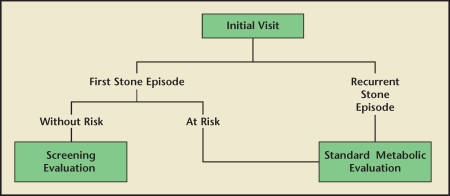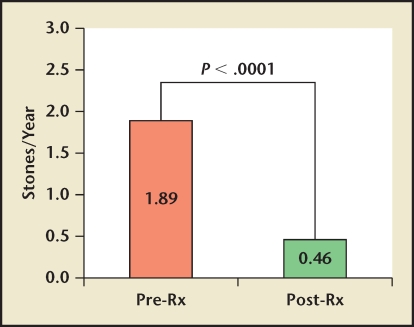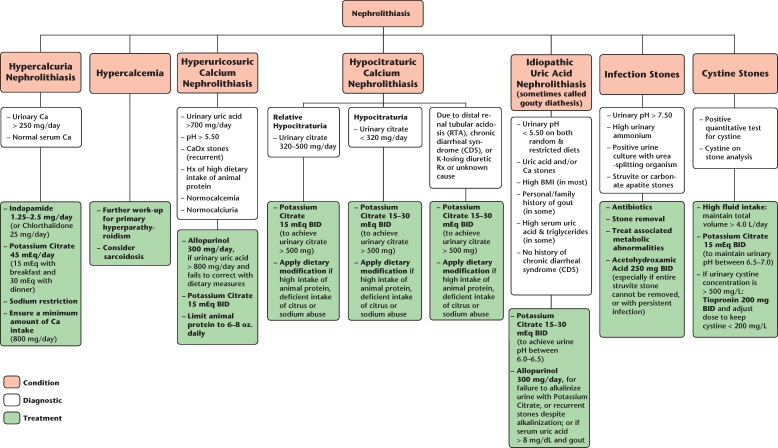Abstract
Nephrolithiasis is a common problem associated with significant costs to the health care system. Its prevalence continues to increase, particularly in women, which is attributed to changes in diet and lifestyle. The costs associated with the evaluation and management of nephrolithiasis in the United States has been estimated to be $1.83 billion, and, without any intervention, the risk of recurrence is high. This article reviews the management options for nephrolithiasis including a new formulation of potassium citrate, Urocit®-K 15 mEq, that allows for dosing flexibility which can lead to improved compliance and tolerability.
Key words: Nephrolithiasis, Standard metabolic evaluation, Hypercalcuria, Struvite stones
The incidence of nephrolithiasis worldwide is approximately 1%. In the United States, the prevalence has increased from 3.2% in the 1970s to 5.2% in the 1990s.1 A recent study suggests that the prevalence of stone disease continues to rise, particularly in women, thought to be due to changes in diet and lifestyle.2 The costs associated with the evaluation and management of nephrolithiasis in the United States has been estimated to be $1.83 billion.3 The recurrence rates for stone disease are high. After an initial stone, there is a 30% to 50% chance of forming a second stone within 5 years.
Given the high recurrence rate after a first time stone episode, an initial metabolic evaluation to search for underlying causes of nephrolithiasis is warranted. In patients presenting with a single stone episode, a risk assessment should be made to determine the extent of the evaluation (Figure 1). There are a number of factors associated with increased risk of recurrent stone formation (Table 1). These include medical conditions such as diabetes or a family history of kidney stones. In addition, certain medications, such as topiramate and guaifenesin, can also contribute to stone formation. Obesity is also a major risk factor for nephrolithiasis.4 Patients with any of these risk factors should be considered at risk and should undergo a standard metabolic evaluation (SME) (Table 2). In addition, recurrent stone formers should undergo a SME. For first-time stone formers without risk factors, a screening evaluation should be performed that consists of a thorough history, basic serum chemistries, and a urinalysis. Any collected stones should also be sent for analysis.
Figure 1.
Algorithm for diagnostic evaluation.
Table 1.
Risk Factors for Stone Development
|
Table 2.
Identification of Metabolic Abnormalities Using Standard Metabolic Evaluation
| Urinary Finding | Implicated Dietary-Environmental Disturbances |
| Total volume (TV) < 2 L/day | Low fluid intake, excessive sweating |
| Sodium (Na) > 200 mEq/day | Salt abuse |
| Oxalate (Ox) > 45 mg/day | Intake of oxalate-rich foods, very low calcium intake |
| Calcium (Ca) > 250 mg/day | High intake of calcium in some cases |
| Uric acid (UA) > 600 mg/day | High animal protein intake |
| Sulfate (SO4) > 30 mmol/day | Excessive animal protein intake |
| Citrate < 500 mg/day | High intake of animal protein and salt |
Stone formation results from super saturation of urine with stone-forming salts. There are also certain urinary inhibitors that help to prevent salts from crystallizing and forming stones. One of the most potent and important inhibitors of calcium oxalate and uric acid stone formation is citrate. The SME consists of two 24-hour urine collections that are analyzed for urinary abnormalities that contribute to stone formation, such as elevated levels of stone-forming salts or low levels of inhibitors of stone formation. An underlying physiologic or environmental cause for nephrolithiasis can be determined in 97% of cases.
Regardless of the underlying metabolic abnormality, certain dietary modifications should be recommended. Patients should be encouraged to increase their fluid intake to greater than 3 L/day to maintain a urine output of at least 2.5 L/day.5 Dietary sodium and oxalate intake should be limited. Patients should also be instructed to minimize consumption of animal proteins. In general, calcium intake should not be restricted even in those with hypercalcuria. The recommendation for patients with hypercalcuria should be a modest calcium intake, approximately 800 mg/day, or 2 to 3 servings of dairy per day.
Hypercalcuria is defined as urine calcium greater than 250 mg/day. The most common cause of elevated urine calcium is absorptive hypercalcuria. In patients with an elevated serum calcium and hypercalcuria, a work-up for hyperparathyroidism should be pursued. For patients with modestly elevated urine calcium and elevated urine sodium, a trial of sodium restriction may be offered as an initial treatment. For patients with normal urine sodium or markedly elevated urine calcium, as well as those who fail sodium restriction, pharmacological management with a thiazide diuretic is the treatment of choice. The most common agents used are indapamide 1.25 to 2.5 mg/day or chlorthalidone 25 to 50 mg/day. When using these agents, potassium supplementation should be provided due to the concern for hypokalemia. Potassium citrate (Urocit®-K 15, Mission Pharmacal, San Antonio, TX) is the preferred agent as it will also increase urinary citrate. Typically, a starting dose would be Urocit-K 15 mEq with breakfast and 30 mEq with dinner. For patients with elevated urinary pH (> 6.5), potassium chloride may be substituted for potassium citrate due to a concern of over-alkalization.
Elevated urine uric acid levels can cause hyperuricosuric calcium oxalate nephrolithiasis. Hyperuricosuria is defined as urinary uric acid levels greater than 800 mg/day. Patients should be counseled to limit animal protein intake to 6 to 8 oz daily. If the uric acid levels fail to correct with conservative measures, allopurinol 300 mg/day can be prescribed.6 Potassium citrate is an alternative to allopurinol.7 Urocit-K 15 mEq with breakfast and dinner may be useful in patients with modest hyperuricosuria, particularly those with hypocitraturia.
Citrate is an important inhibitor of stone formation. It inhibits calcium salt crystallization and raises urinary pH by acting as a buffer. Hypocitraturia, defined as urinary citrate less than 500 mg/day, is a risk factor for calcium nephrolithiasis. Potassium citrate has been demonstrated to reduce the stone formation rates by 96% in patients with hypocitraturia.8 The response to potassium citrate has also been shown to be durable.9 With a median of 41 months follow-up, urinary pH and citrate levels remained significantly higher in patients treated with potassium citrate when compared with pretreatment values. Potassium citrate also significantly decreased the stone formation rate in this long-term clinical trial (Figure 2). The dosage should be titrated with a goal of a urinary citrate level greater than 500 mg/day. Urocit-K has recently been formulated into a 15 mEq tablet, providing greater dosing flexibility and the potential to reduce the total number of tablets required. A reasonable starting dose for modest hypocitraturia would be one Urocit-K 15 mEq with breakfast and dinner. For patients with more significant hypocitraturia, the recommendation is for Urocit-K 15 mEq with breakfast and 30 mEq with dinner.
Figure 2.
Stone formation rates pretreatment and posttreatment with potassium citrate.9
Idiopathic uric acid nephrolithiasis is commonly associated with gouty diathesis, or low urinary pH. Alkalization of the urine can not only prevent future uric acid stones from forming, but can potentially dissolve existing stones. The goal of alkalization should be a urinary pH between 6.0 and 6.5. This is best achieved with potassium citrate. Urocit-K is usually prescribed with a dose between 15 to 30 mEq with breakfast and dinner. The dose can be titrated to obtain the desired pH. In cases where patients continue to form uric acid stones despite adequate alkalization, or if serum uric acid levels exceed 8 mg/dL, allopurinol 300 mg/day may be added.
Potassium citrate has a role in the treatment of cystine stones as well. Patients with cystine stones should be instructed to increase their fluid intake to maintain a urine volume greater than 4 L/day. In addition, potassium citrate should be prescribed to maintain urinary pH between 6.5 and 7.0. The usual dose would be Urocit-K 15 to 30 mEq with breakfast and dinner. Tiopronin (Thiola®, Mission Pharmacal) should be initiated when cystine concentration is greater than 250 mg/L. Thiola is started at 200 mg twice per day. The dose is adjusted to maintain urinary cystine concentrations below 200 mg/L.
Infection stones, or struvite stones, are associated with urease-splitting bacteria. Patients often present with recurrent urinary tract infections and large stones. Patients with a stone analysis revealing 100% struvite often do not require a SME. If risk factors are present, or if there is a component of calcium nephrolithiasis on the stone analysis, a SME should be considered. The treatment of infected stones consists of complete stone removal. Patients should also be placed on prophylactic antibiotics. Acetohydroxamic acid (Lithostat®, Mission Pharmacal) is a urease inhibitor that is useful in patients in whom the entire stone cannot be removed or in patients with persistent infection. It is prescribed at a dose of 250 mg twice per day. Any associated metabolic abnormalities found on a SME should be treated appropriately.
Nephrolithiasis is a common problem associated with significant costs to the health care system. The prevalence of nephrolithiasis continues to increase. Without any interventions, the risk of recurrence is high. Recurrent stone formers and first-time stone formers with risk factors for recurrence should undergo a SME. An underlying etiology for stone formation can be found in 97% of patients. Once a metabolic abnormality is found, targeted medical therapy can be initiated (Figure 3).10 The majority of medications used to prevent stone recurrence are well tolerated and highly effective. In particular, potassium citrate can reduce stone formation rates by up to 96% and has durable long-term effects. A new formulation of potassium citrate, Urocit-K 15 mEq tablets, increases dosing flexibility leading to improved compliance and tolerability.
Figure 3.
Medical management of nephrolithiasis from the ABC’s of Medical Management of Stones.10
Main Points.
Due to the high recurrence rates after a first-time stone episode, an initial metabolic evaluation to search for the underlying causes of nephrolithiasis is recommended. Risk factors include diabetes or a family history of kidney stones, use of medications such as topiramate and guaifenesin, and obesity.
Regardless of the metabolic abnormality, dietary modifications are recommended, as well as increased fluid intake. Patients should limit their sodium and oxalate intake and minimize consumption of animal proteins. Calcium intake should not be restricted.
Elevated urine uric acid levels can cause hyperuricosuric calcium oxalate nephrolithiasis. Patients should limit animal protein intake to 6 to 8 oz daily. If uric acid levels fail to correct with conservative measures, allopurinol 300 mg/day can be prescribed. Potassium citrate is also an alternative to allopurinol.
Targeted medical therapy can be initiated once a metabolic abnormality is found. Medications used to prevent stone recurrence are well tolerated and highly effective. Potassium citrate can reduce stone formation rates by up to 96% and has durable longterm effects. Urocit-K 15®, a new formulation of potassium citrate, increases dosing flexibility leading to improved compliance and tolerability.
Footnotes
A simple step-by-step approach to the diagnosis and prevention of nephrolithiasis is available in the ABC’s of Medical Management of Stones10 and ABCs of Kidney Stones: A Patient’s Guide to Help Prevent Recurrent Kidney Stones11 at stonedisease.org or a complimentary copy may be obtained from Mission Pharmacal.
Glenn M. Preminger, MD, serves as a consultant for Mission Pharmacal.
References
- 1.Stamatelou KK, Francis ME, Jones CA, et al. Time trends in reported prevalence of kidney stones in the United States: 1976–1994. Kidney Int. 2003;63:1817–1823. doi: 10.1046/j.1523-1755.2003.00917.x. [DOI] [PubMed] [Google Scholar]
- 2.Scales CD , Jr, Curtis LH, Norris RD, et al. Changing gender prevalence of stone disease. J Urol. 2007;177:979–982. doi: 10.1016/j.juro.2006.10.069. [DOI] [PubMed] [Google Scholar]
- 3.Clark JY, Thompson IM, Optenberg SA. Economic impact of urolithiasis in the United States. J Urol. 1995;154:2020–2024. [PubMed] [Google Scholar]
- 4.Taylor EN, Stampfer MJ, Curhan GC. Obesity, weight gain, and the risk of kidney stones. JAMA. 2005;293:455–462. doi: 10.1001/jama.293.4.455. [DOI] [PubMed] [Google Scholar]
- 5.Borghi L, Meschi T, Amato F, et al. Urinary volume, water and recurrences in idiopathic calcium nephrolithiasis: a 5-year randomized prospective study. J Urol. 1996;155:839–843. [PubMed] [Google Scholar]
- 6.Ettinger B, Tang A, Citron JT, et al. Randomized trial of allopurinol in the prevention of calcium oxalate calculi. N Engl J Med. 1986;315:1386–1389. doi: 10.1056/NEJM198611273152204. [DOI] [PubMed] [Google Scholar]
- 7.Pak CY, Peterson R. Successful treatment of hyperuricosuric calcium oxalate nephrolithiasis with potassium citrate. Arch Intern Med. 1986;146:863–867. [PubMed] [Google Scholar]
- 8.Preminger GM, Harvey JA, Pak CY. Comparative efficacy of “specific” potassium citrate therapy versus conservative management in nephrolithiasis of mild to moderate severity. J Urol. 1985;134:658–661. doi: 10.1016/s0022-5347(17)47371-x. [DOI] [PubMed] [Google Scholar]
- 9.Robinson MR, Leitao VA, Haleblian GE, et al. Impact of long-term potassium citrate therapy on urinary profiles and recurrent stone formation. J Urol. 2009;181:1145–1150. doi: 10.1016/j.juro.2008.11.014. [DOI] [PubMed] [Google Scholar]
- 10.Pearle MS, Preminger GM, Goldfarb DS, et al. ABC’s of Medical Management of Stones. 2nd ed. San Antonio, TX: Mission Pharmacal Company; 2010. Available at StoneDisease.org. [Google Scholar]
- 11.ABCs of Kidney Stones: A Patient’s Guide to Help Prevent Recurrent Kidney Stones. San Antonio, TX: Mission Pharmacal Company; 2011. [Accessed March 17, 2011]. http://www.stonedisease.org/sites/default/files/abcs_booklet_for_patients.pdf. [Google Scholar]





